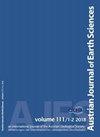东阿尔卑斯山脉Koralpe以南变质岩场梯度的构造解释
IF 1.1
4区 地球科学
Q2 Earth and Planetary Sciences
引用次数: 7
摘要
摘要为了约束阿尔卑斯山东端始高山高压带性质的构造模型,我们沿着Koralpe和Pohorje山脉南部著名的超高压岩石之间的剖面研究了变质岩的形成压力。考虑了来自三个不同地区的岩石:(i)北部最南端Koralpe的岩石,(ii)Plankogel支队和Drava山谷之间的Plankogele单元的岩石,以及(iii)Possruck山脉和南部Pohorje山脉之间的岩石。据文献报道,在Koralpe,泥质岩石记录的地层压力约为15-18kbar。对于Plankogel单元,我们推导出650°C下7.1±1.95 kbar和11.5±3.42 kbar之间的压力,并且只识别出一次始高山变质事件。对于Pohorje山脉的高品位岩石,我们得出了峰值变质压力(用石榴石-白云母-蓝晶石-石英组合勘探),从北部的16.2±3.45 kbar(700°C)上升到南部的23.9±2.49 kbar(70°C)。在那里,我们还认识到一个后来的低压事件,它是从具有完全平衡组合的压力计算中导出的。对于Pohorje山脉内的整个南北断面,这一低压事件在650°C时产生了大约10±2 kbar的类似条件。Koralpe和Pohorje地区的峰值变质条件与每10公里距离约1.3 kbar的连续场梯度相匹配,对应于假设岩石静定条件下每公里距离约0.5公里的深度增加。我们认为,这支持了这两个单元可以一起被解释为45°倾斜的俯冲板块。在这个俯冲板块之上,可以推断,提取了一个位于Plankogel单元和高压岩石之间的板块,导致了第一个剥露阶段,该阶段与俯冲板块向地壳中部水平的浮力向上倾斜有关。在该模型中,Plankogel单元位于提取板的上壁中,Plankogel分离形成提取板的缝合线。由于侵蚀和正断层作用,在第二阶段发生了从地壳中部水平面到地表的渗出。这种正断层作用导致了Pohorje山脉相对于Koralpe向上位移约10公里,并最终导致了当前在地图尺度上的岩性分布。本文章由计算机程序翻译,如有差异,请以英文原文为准。
Tectonic interpretation of the metamorphic field gradient south of the Koralpe in the Eastern Alps
Abstract In order to constrain tectonic models for the nature of the Eoalpine high pressure belt at the eastern end of the Alps, we investigate the formation pressure of metamorphic rocks along a profile between the Koralpe and the well-known UHP rocks of the southern Pohorje mountains. Rocks from three different regions are considered: (i) the rocks of the southernmost Koralpe to the north, (ii) the rocks of the Plankogel Unit between the Plankogel detachment and the Drava valley and (iii) the rocks between the Possruck range and the southern Pohorje mountains. In the Koralpe, pelitic rocks record a formation pressure around 15 – 18 kbar, as reported in the literature. For the Plankogel Unit, we derive pressures between 7.1 ± 1.95 kbar and 11.5 ± 3.42 kbar at 650 °C and recognize only a single Eoalpine metamorphic event. For the high grade rocks of the Pohorje mountains, we derive peak metamorphic pressures (explored with the garnet-muscovite-kyanite-quartz assemblage) that rise from 16.2 ± 3.45 kbar (at 700°C) in the north, to 23.9 ± 2.49 kbar (at 700 °C) in the south. There, we also recognize a later lower pressure event that is derived from pressure calculations with the full equilibrium assemblage. This lower pressure event yields similar conditions around 10 ± 2 kbar at 650 °C for the entire north-south transect within the Pohorje mountains. Peak metamorphic conditions in the Koralpe and Pohorje regions are matched by a continuous field gradient of about 1.3 kbar per 10 kilometers distance corresponding to a depth increase of about 0.5 km per kilometers distance assuming lithostatic conditions. We suggest that this supports that the two units may be interpreted together in terms of a 45° dipping subducting plate. Above this subducting plate, it is inferred that a slab was extracted that was located between the Plankogel Unit and the high pressure rocks, causing a first exhumation stage that is associated with buoyant upwards tilting of the subducted slab to mid crustal levels. Within this model, the Plankogel Unit was located in the hanging wall of the extracted slab and the Plankogel detachment forms the suture of the extracted slab. Exhumation from mid crustal levels to the surface during a 2nd stage occurred due to erosion and normal faulting. This normal faulting is responsible for some 10 km of upward displacement of the Pohorje mountains relative to the Koralpe and ultimately for the current distribution of lithologies on a map scale.
求助全文
通过发布文献求助,成功后即可免费获取论文全文。
去求助
来源期刊

Austrian Journal of Earth Sciences
Earth and Planetary Sciences-Paleontology
CiteScore
3.10
自引率
0.00%
发文量
0
审稿时长
>12 weeks
期刊介绍:
AUSTRIAN JOURNAL OF EARTH SCIENCES is the official journal of the Austrian Geological, Mineralogical and Palaeontological Societies, hosted by a country that is famous for its spectacular mountains that are the birthplace for many geological and mineralogical concepts in modern Earth science.
AUSTRIAN JOURNAL OF EARTH SCIENCE focuses on all aspects relevant to the geosciences of the Alps, Bohemian Massif and surrounding areas. Contributions on other regions are welcome if they embed their findings into a conceptual framework that relates the contribution to Alpine-type orogens and Alpine regions in general, and are thus relevant to an international audience. Contributions are subject to peer review and editorial control according to SCI guidelines to ensure that the required standard of scientific excellence is maintained.
 求助内容:
求助内容: 应助结果提醒方式:
应助结果提醒方式:


